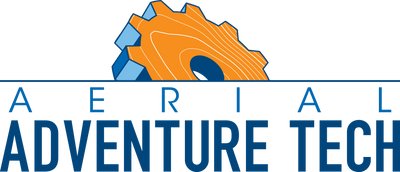Marking and Labeling Guidelines
Marking & Labeling Guidelines
 All aerial adventure equipment should be marked or labeled with a unique identifier. These unique identifiers allow you to tie your products to inspection, maintenance, and purchase records. Additionally, unique identifiers can be tied to serial numbers on equipment. Serial numbers can serve the same purpose but do not integrate well with your organizational coding system and can be cumbersome to read. By maintaining the unique identifier, serial numbers that wear off, or become illegible, over time can still be accessed in the event of a recall or special inspection notice. Marking and labeling equipment can also be important for batching (grouping) products, placing items at certain locations on a site, or ensuring rotational use of equipment. Unique identifiers can be coded either alpha-numerically, by color, or some combination of the two.
All aerial adventure equipment should be marked or labeled with a unique identifier. These unique identifiers allow you to tie your products to inspection, maintenance, and purchase records. Additionally, unique identifiers can be tied to serial numbers on equipment. Serial numbers can serve the same purpose but do not integrate well with your organizational coding system and can be cumbersome to read. By maintaining the unique identifier, serial numbers that wear off, or become illegible, over time can still be accessed in the event of a recall or special inspection notice. Marking and labeling equipment can also be important for batching (grouping) products, placing items at certain locations on a site, or ensuring rotational use of equipment. Unique identifiers can be coded either alpha-numerically, by color, or some combination of the two.Examples of how this can be implemented at your site follow:
1. There are three belay devices in your inventory. You could label them BD1, BD2, and BD3.
2. There are five harnesses intended for use in the kid’s area (painted blue) of a gym. You could tag them all with blue tags that are numbered 1 through 5.
3. You want to create a rescue kit consisting of a rope, descent control device, and carabiner. You could label the overall kit RK1 and the respective individual components RK1R1, RK1DC1, and RK1C1.
4. There is a spool of rope to be cut into multiple lengths. You will want to represent that each individual rope came from that spool (the second one you have purchased). The ropes could be labeled R2a, R2b, R2c, etc.
Whatever system you come up with, ensure that it is both intuitive and usable for your staff.
When marking and labeling aerial adventure products, use the following guidelines:
- Labels should be semi-permanent at minimum and reasonably resistant to loss or wear.
- The best place to label a product is usually where the manufacturer has labeled it, as this area is the least likely to compromise the strength of the product or interfere with use.
- Never cover up or make illegible manufacturer markings. If this must be done, ensure that information is captured and tied to that product.
- Tie labels (and unique identifiers) to the product serial number as soon as possible to limit the possibility of losing a serial number.

Metallic Products
- Marking and labeling options include tags, stickers, metallic paint, barcodes, RFID chips, and electric engravers
- Avoid marking where there is heavy wear (e.g. where a rope runs through a carabiner)
- Avoid marking in high stress areas (e.g. near set screws, rivets, bolts, or carabiner locking sleeves)
- Never use a stamp or punch on metallic items
- Never engrave deeper than 0.1 mm
Our favorites:
Electric engravers
Embedded RFID products
Textile Products
- Marking and labeling options include tags, tape, stickers, indelible pen, barcodes, and RFID chips
- Place labels or tags on comfort components only
- Only write on manufacturer tags, never on the textile itself
- Do not puncture critical textiles
- Never tag an item where it could be accidentally attached to (e.g. never tag a belay loop on a harness) or where it can compromise the strength of a critical component
Our favorites:
Engraved metal tags
RFID zip ties
Helmets
- Marking and labeling options include tags, tape, manufacturer approved stickers, barcodes, and RFID chips
- Never mark on the shell of the helmet unless it is on top of a helmet manufacturer approved sticker
- Do not engrave the shell
- Do not place stickers on helmets unless they are placed on top of manufacturer approved stickers
- Do not tag or label the fit adjustment system of the helmet where it will interfere with the adjustment
 Our favorites:
Our favorites:
Engraved metal tags
Manufacturer approved stickers
RFID zip ties
Ropes
- Marking and labeling options include tags, tape, whip end dip, heat shrink labels, end caps, barcodes, and RFID chips
- Only label the last few unusable inches
- If a rope is cut, it must be relabeled on both ends
- If a rope is cut from a spool, tie the rope to information about that spool
- RFID chips can be inserted into the rope ends with a syringe
- Both rope ends must be labeled
- Information about the rope can sometimes be found on internal tracers
- Ropes ends should be labeled with the following information:
- The name of the manufacturer
- The type of rope
- The length
- The diameter
- The year of manufacture
- The date in service
- The unique identifier
- The product serial number
Our Favorites:
Rope labels
Whip End Dip
Heat shrink caps
